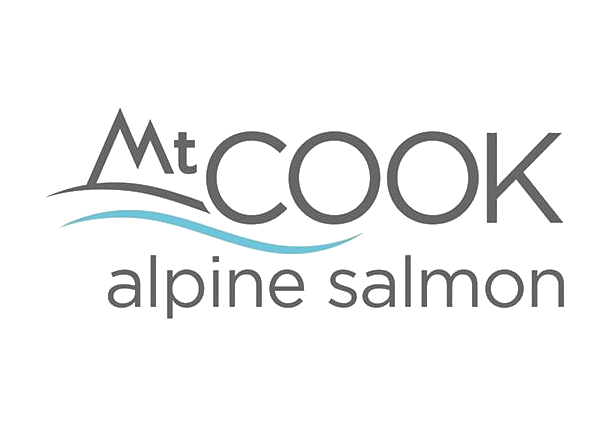King salmon vs. Other salmon varieties: What’s the difference?
You’ve probably heard people waxing lyrical about New Zealand King Salmon like it’s the absolute bees freaking knees and TBH, it kind of is. But what’s the actual deal? How does King Salmon stack up against other varieties like Atlantic or sockeye? Let’s break it down, fish by fish, so you know exactly what you’re sinking your chops into.
King Salmon
Also known as Chinook, this salmon is a species of Pacific salmon. With a higher fat content than any other variety and deep, orange-coloured flesh, it’s melting and rich, with a silky, luxurious texture that makes every bite a treat. The high fat content doesn’t just enhance the flavour and texture— it also means this fish can handle a range of cooking methods without drying out. Whether you’re grilling, poaching, or even curing it, it retains that incredible, buttery texture. Because of all the lovely, fishy fat, this is the ultimate salmon for serving raw.
Mt Cook Alpine Salmon, a premium South Island producer, represents the absolute pinnacle of salmon farming. Raised in the pristine Southern Alps, their salmon benefit from water that’s as clean and untouched as it gets. Plus, Mt Cook Alpine Salmon uses cutting-edge eco-friendly methods, including low-density farming to ensure the fish grow slowly and naturally. This, combined with sustainable feed, makes these fish totally top-tier and the salmon of choice for leading chefs. It’s buttery beyond belief and we think it’s the best salmon money can buy. Even leading Aussie chefs prefer it!
King Salmon is a powerhouse of nutrition; it’s packed with omega-3 fatty acids, which are not only good for your heart but also your brain. So, essentially, eating King Salmon makes you smarter (probably).
Atlantic Salmon
If King Salmon is fish royalty, Atlantic is more like the everyday bloke. Well, kind of – it’s not exactly cheap, but nor does it have the cachet of King Salmon.
Atlantic salmon is the main type of salmon farmed in Tasmania, and it’s also farmed extensively in places like Norway, Chile, and Scotland. Farmed Atlantic salmon raises pretty big concerns around sustainability, with water pollution, disease and the impact on wild populations the main issues. With a slightly firmer texture, lighter flesh colour and a generally smaller size than King, it’s great in dishes like curries, pilafs, risottos, soups, grills and stir-fries. But if you’re after more of a centerpiece/show-stopper, Atlantic doesn’t hold a candle to the lush gorgeousness of King Salmon.
On the nutrition front, Atlantic Salmon still brings the goods, with a solid hit of omega-3s and protein. But if you’re keeping score, it’s a bit leaner than King Salmon, meaning less of that glorious fat that gives salmon its signature richness.
Sockeye Salmon
Sockeye Salmon, or red salmon as it’s often called, is the wild child of the group, literally—it’s almost always wild-caught. Its deep red colour comes from its diet, which also gives it an intense, almost gamey flavour. Some love it for its robustness, but it’s quite different from King Salmon.
Texture-wise, sockeye is firmer and a bit drier than both Atlantic and King, which makes it excellent for grilling or smoking. But because it’s leaner, you don’t get that buttery, melt-in-the-mouth experience you get with King Salmon. You’re most likely to come across this fish canned in New Zealand as they’re native to North America, the Kamchatka region of Russia, and northern Japan. New Zealand does have a small , non-commercial population of sockeye in the Waitaki River catchment however, which is the only known population in the southern hemisphere. Unlike their wild counterparts, these Sockeyes are landlocked, which is significant as this type of salmon is what’s known as anadromous. Which means they hatch from eggs in freshwater, migrate to the sea where they spend most of their lives, then return to their rivers of origin to spawn and die.
Which Salmon Wins?
If you’re after the ultimate experience, New Zealand King Salmon takes the crown. Its extraordinary melting texture and rich flavour make it a stand-out, whether you’re grilling, sashimi-ing, or just enjoying it with a simple squeeze of lemon. Plus, it’s a nutritional powerhouse, with all those healthy fats making you feel like a champion of good eating.
A bit less rich, Atlantic Salmon is a solid everyday option. It’s mild, versatile, and still packs enough omega-3s to keep you feeling virtuous.
Sockeye is kind of a non-starter, unless you’re opening a can. And hey, canned salmon has its place! In fish cakes, pastas, dips, on grain bowls or in salads, it can work a treat.
Now, pass the lemon, would you?
Proudly partnering with Mt Cook Alpine Salmon. When it’s time to go salmon shopping, please show them some love. For stockists click here, for salmon recipes and more click here.










